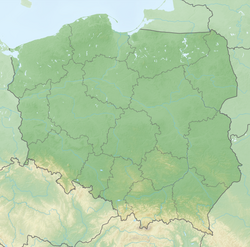Battle of Pułtusk (1703)
| date | April 21 (swedish) / 1. May (greg.) 1703 |
|---|---|
| place | Pułtusk , Poland |
| output | Victory of the Swedes |
| Parties to the conflict | |
|---|---|
| Commander | |
| Troop strength | |
| 3000 | 3500 |
| losses | |
|
12 dead |
several hundred dead, 700 prisoners |
1st phase: Swedish dominance (1700–1709)
Riga I • Jungfernhof • Varja • Pühhajoggi • Narva • Pechora • Düna • Rauge • Erastfer • Hummelshof • Embach • Tartu • Narva II • Wesenberg I • Wesenberg II
Arkhangelsk • Lake Ladoga • Nöteborg • Nyenschanz • Neva • Systerbäck • Petersburg • Vyborg I • Porvoo • Neva II • Koporje II • Kolkanpää
Vilnius • Salads • Jacobstadt • Walled Courtyard • Mitau • Grodno I • Olkieniki • Nyaswisch • Klezk • Ljachavichy
Klissow • Pułtusk • Thorn • Lemberg • Warsaw • Posen • Punitz • Tillendorf • Rakowitz • Praga • Fraustadt • Kalisch
Grodno II • Golovchin • Moljatichi • Rajowka • Lesnaja • Desna • Baturyn • Koniecpol • Weprik • Opischnja • Krasnokutsk • Sokolki • Poltava I • Poltava II
2nd phase: Sweden on the defensive (1710–1721)
Riga II • Vyborg II • Pernau • Kexholm • Reval • Hogland • Pälkäne • Storkyro • Nyslott • Hanko
Helsingborg • Køge Bay • Gulf of Bothnia • Frederikshald I • Dynekilen Fjord • Gothenburg I • Strömstad • Trondheim • Frederikshald II • Marstrand • Ösel • Gothenburg II • Södra Stäket • Grönham • Sundsvall
Elbing • Wismar I • Lübow • Stralsund I • Greifswalder Bodden I • Stade • Rügen • Gadebusch • Altona • Tönning II • Stettin • Fehmarn • Wismar II • Stralsund II • Jasmund • Peenemünde • Greifswalder Bodden II • Stresow
In the Battle of Pultusk on April 21 (Sweden) / 1. May 1703 (greg.) 1703 was in the course of the Great Northern War a Saxon-Lithuanian army from a cavalry division under the command of Charles XII. beaten.
prehistory
In the first months of 1703 the war in Poland ceased. In March Charles XII broke. with his army towards Warsaw , which he reached in early April. At the beginning of April 1703 August II left Dresden for Thorn and Marienburg in order to start the new campaign from there. After the defeat in the previous year in the Battle of Klissow , August II used the time to build a new Saxon-Lithuanian army. This army camped at Pułtusk . Charles XII. decided to destroy this army. With a strong army he rode out of Warsaw. Because of the many waterways that had to be passed, he left infantry and artillery behind. With the cavalry he crossed the bow and reached on April 21st (Sweden) / 1. May 1703 (greg.) 1703 Pultusk. At that time the city was only on an island in the Narew .
course
Field Marshal Adam Heinrich von Steinau , who commanded the Saxon army, had no inkling of the actual strength of the Swedes and initially only expected a smaller battle. When he saw the entire cavalry, he assumed that the Swedish infantry was also present. He immediately had his troops withdraw to the city. Charles XII. had the retreat route of the Saxons cut off by a dragoon regiment . The Swedish dragoons managed to penetrate the city at the same time as the Saxons, whereupon Charles XII. streamed into town with the rest of the cavalry. Lithuanians and Saxons fled the city across the bridge of the southern arm of the Narew with almost no resistance. They demolished this bridge too early to prevent the Swedes from persecuting it. Due to the failure of the only escape route, many Saxons who were still in the city were cut off and were massacred, driven into the river or captured by the invading Swedes. Soon the southern bridge could be restored so that the pursuit of the fleeing Saxons and Lithuanians could be resumed.
Result
The battle cost the Swedes only twelve men, while the Saxons and Lithuanians had several hundred dead and 700 prisoners. Field Marshal Steinau was able to escape while August II was staying in Marienburg, where he was watching a play in which the Saxons defeated the Swedes.
literature
- Different from Fryxell: Life story of Karl the Twelfth, King of Sweden, Volume 1, Leipzig 1860, p. 95ff

